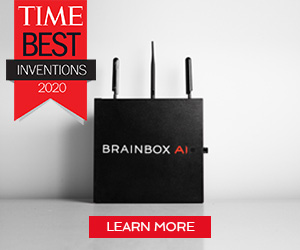Cisco: The Backbone of Smart Buildings

When not talking about COVID, it seems like these days everyone is talking about smart buildings.
This is for good reason. The number of IoT devices available to integrate into our built environment is growing exponentially, and there are myriad ways that these innovations can be used to improve our experience in the workplace, in education and in commercial spaces.
The smart building movement ties right into what we at Cisco have been saying for a while: that the network is becoming central to every aspect of how organizations do their work. Data connectivity is truly the 4th utility – just consider how long people will wait for a pause in water service compared to how quickly they will call IT if the internet goes down.
Data plus power
Take a moment and consider the smart devices we’re putting into our built environment nowadays. We’ve got HVAC controls, connected LED lighting systems and digital screens with built-in facial recognition. Sensors can detect if a room is unoccupied despite being reserved so that the space is made available for other bookings. Ultraviolet lights can turn on when rooms are emptied to disinfect the environment.
Cisco’s networking solutions provide both data communication as well as power via Power over Ethernet (PoE) for all the devices employed in a smart building. This allows for great energy savings by delivering low voltage power throughout the building, thus eliminating the energy losses that happen with A/C to D/C converters. And now, new 90W UPOE+ switches let you put many more devices on each line from a single port, with power usage monitored on a per port basis right from the network management platform.
"Running your equipment with PoE is an easy way to switch over to low voltage power throughout the building. This eliminates the power losses at A/C to D/C converters all over the place, saving a great amount on energy costs,” says Farukh Aslam, CEO and President of Sinclair Holdings, a Marriott Autograph Hotel which recently underwent renovation and conversion to smart building technology.
Intelligent decisions based on better data
The benefits of these innovations go beyond just energy and operational efficiency. The network should be the platform that aggregates all the data from the various building systems so that it can be analyzed and used to identify trends and make intelligent decisions leading to better space utilization that fits behavior and adapts to how people work in the future.
Health and security are paramount
Security and health are important outcomes for smart buildings as well, especially as businesses bring people back to the workplace. For example, solutions such as Cisco DNA Spaces make it easier to ensure a safe environment when workers return to the office, or retailers bring customers back into their stores. With this, the wireless network is used to providing real-time visibility into occupational density to help monitor social distancing.
There’s also more awareness now of cyber security risks with IoT devices. One benefit of Cisco technology is that advanced security features are built into the devices, and the company continues to lead the way in reducing vulnerabilities across the network. A great example of this is the new MUD (Manufacturer Usage Description) security standard: When a new thing powers up on a network port, the network can automatically identify what it is and assign it the right set of network policies. This way, IT should feel more comfortable giving control to Office Services without worrying that back doors in the IoT devices can be exploited to get into the network.
Importance of the partner ecosystem
Cisco is excited to be a part of the ecosystem of device manufacturers and application providers because of the value in the shared development process. It has partnered with many device manufacturers and application developers such as Igor Technologies, Johnson Controls, IBM and more. We consider this to be essential for creating the best customer outcomes possible.
“An ecosystem mindset is critical in this field – no one company can do it alone, at least not well. We encourage clients to dream big when designing their buildings because we know we have partners that can make their vision come alive,” says Kim Johnson of Igor Technologies, whose Nexos software acts as centralized control, automation and analytics for connected building management systems.
Compatibility a key factor for success
PoE is a global standard, an advantage over plugged-in power that makes the pool of options bigger and protects customers’ investments in technology even if some players go out of business.
Software compatibility is important as well. We believe the network needs to be an open platform that can accommodate new technologies as they are developed. The latest generation of core and access switches include programmable chipsets, enabling developers to continue to further improve integration of systems.
“It’s often the case that clients go and look for point solutions for things like lighting or HVAC controls. But once they have several of these in place, they realize that it’s hard to manage them all separately. With Cisco connecting both the wired and wireless devices all that data can be pulled into a partner application to make it easy to manage everything together,” says Scott Panzer, Vice Chairman of Jones Lang LaSalle.
Bringing IT into the decision process
Traditionally, IT was neither a major stakeholder in the decision-making process of building design, nor did it play a key role in determining the direction of the company. This is no longer the case. As the backbone of the smart building, decisions about network hardware and software have long-ranging consequences for how well the business will be able to leverage the new IoT technologies.
Building business resilience with an agile network
Cisco has been leading the way toward intent-based networking, in which the management of the network is tightly aligned with the needs of the business. The result is a resilient business that can adapt quickly even in the face of major shifts of circumstances. You can hear more about our smart building solutions in a recent webinar.
This Week’s Sponsor
Altus Group Limited is a leading provider of independent advisory services, software and data solutions to the global commercial real estate industry. Featuring our industry-leading ARGUS® software solutions, for the past 25 years ARGUS products have been the industry standard for creating cash flows and valuations helping thousands of commercial real estate professionals gain transparency into their property assets, manage risk and optimize their portfolios. www.altusgroup.com/argus/
Read Next
 5/15/2025
5/15/2025
Tech, Talent and Transformation: 2025 Digie Finalists Announced For 27 years, Realcomm has presented the Digie Awards to acknowledge companies, real estate projects, technologies, and individuals that have advanced the commercial real estate industry through the strategic use of technology, automation, and innovation.
 5/15/2025
5/15/2025
Empowering Space Management with Data-Driven Visualization For effective CRE space management, it’s critical to centralize lease data, maximize rental square footage (RSF), improve energy efficiency and reconfigure spaces to meet changing needs.
 5/8/2025
5/8/2025
The AI-Powered Workplace Evolution: Redefining the Business Landscape In today's rapidly evolving business environment, the fusion of Artificial Intelligence (AI) and Workplace Management is revolutionizing the way organizations approach workspace optimization and operational efficiency.
 3/27/2025
3/27/2025
The Convergence of Edge Computing, Cloud, and AI in Building Automation and Smart Buildings In the built environment, we have seen the convergence of Operational Technology (OT) and Information Technology (IT), later expanding to include Workplace Technologies (WP).









%20(1)%20(1)%20(1).png)




